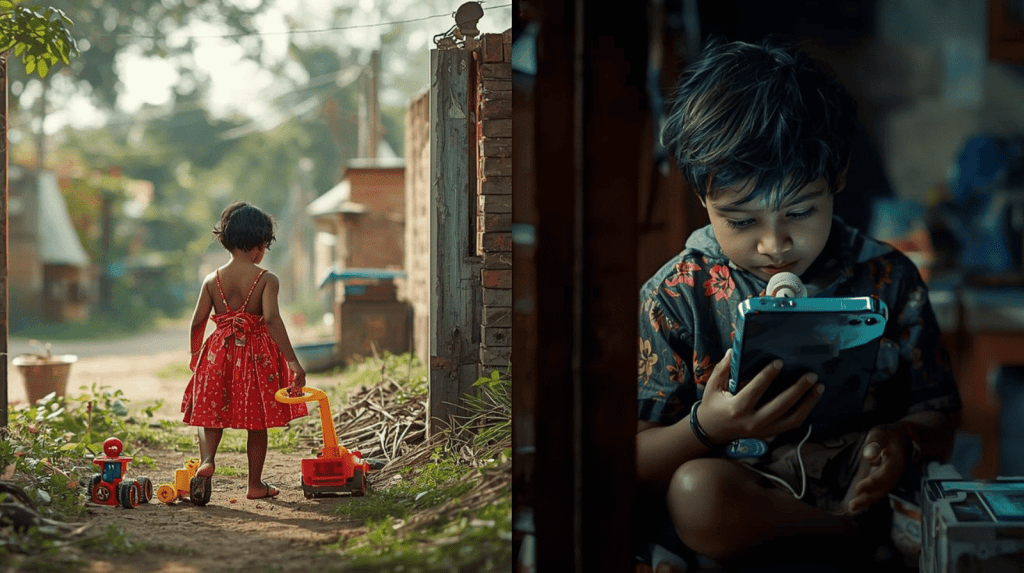
The Playground Divide: A Tale of Two Childhoods in a Karnataka Village
The landscape of a Karnataka village, with its temple courtyards, sprawling banyan trees, and sun-baked fields, has physically changed over the last four decades. But a more profound transformation has occurred in the life of its youngest residents. The laughter, the games, and the very definition of “playtime” for a child in the 1980s and a child today are worlds apart.
Here’s a look at the two childhoods, viewed through the lens of the games they played.
The 1980s Village Kid: The Era of Open Gates and Endless Evenings
For a child growing up in a Karnataka village in the 1980s, the world was their playground. The day was bookended by school and chores, but the long, golden evenings were a sacred, unstructured time for play.
- The Arena: The play area was boundless and organic. It was the dusty lane in front of the house, the cool, stone-paved ground of the local devasthana (temple), the harvested paddy field, or any patch of earth large enough to host a game. Safety was a community affair, and the outdoors were seen as a place of freedom, not fear.
- The Games: The games required little to no equipment, relying instead on creativity, teamwork, and raw physical energy.
- High Energy: Lagori (seven stones), Kabaddi in the soft mud, Kho-Kho, and the local version of hide-and-seek called Kanna Muchale.
- Skill-Based: Goli Aata (marbles) was a game of immense focus and a source of prized collections. The Buguri (wooden spinning top) was an art form, with contests to see whose top spun the longest or could be scooped up mid-spin. Chinni Dandu (a game similar to Gilli Danda) tested hand-eye coordination.
- Simple Pastimes: Kunte Bille (hopscotch) grids were scratched into the dirt with a stone. Girls often engaged in group skipping games with long ropes.
- The Social Circle: Play was an intensely social, face-to-face activity. Groups were a mix of ages, with older children naturally teaching the rules to the younger ones. There were no scheduled “playdates”; you simply stepped out of your house and joined the game that was happening. Arguments were frequent, but so was resolution—they were the first lessons in negotiation and sportsmanship.
Today’s Village Kid: The World in a Screen, The Playground in a Pocket
The village of today is more connected, more developed, and paradoxically, more isolating for a child. The open fields are shrinking, and parental concerns, coupled with academic pressure, have reshaped the concept of leisure.
- The Arena: The playground has moved indoors. It now exists on a 6-inch mobile screen or a television. Outdoor play, if it happens, is often confined to a specific school ground or a small, designated park. The streets are no longer considered safe for spontaneous games due to increased traffic.
- The Games: Digital entertainment is the undisputed king.
- Primary Games: Mobile games—from global sensations like Battlegrounds Mobile India (BGMI) and Free Fire to simpler puzzle games like Candy Crush—are the new norm. The competition is online, with players connecting through voice chat.
- Entertainment: Beyond interactive games, a significant portion of “playtime” is spent consuming content on platforms like YouTube, watching cartoons, gaming streams, or short-form videos on apps like Instagram Reels.
- Fading Traditions: Traditional games are a novelty, usually played only during a school’s sports day or a village festival (jaatre). The knowledge of their rules is fading from the collective memory of the younger generation.
- The Social Circle: While children are more connected than ever in a digital sense, their physical social circle for play has shrunk. They play with online friends or schoolmates in multiplayer games. Spontaneous interaction with neighbourhood children has drastically reduced. Socializing is often mediated through a screen, changing the nature of friendship and communication.
Comparison at a Glance
| Aspect | The 1980s Village Kid | The Modern Village Kid |
| Play Arena | Open fields, temple grounds, dusty village lanes. | Indoors, on a mobile screen, or in structured school playgrounds. |
| Primary Games | Lagori, Kabaddi, Goli Aata, Buguri, Kho-Kho, Kunte Bille. | Mobile games (BGMI, Free Fire), online multiplayer games, console games. |
| Source of Fun | Physical activity, social interaction, achieving a physical goal. | Digital rewards, levelling up, online competition, content consumption. |
| Playmates | Mixed-age neighbourhood kids, siblings, cousins. | Online friends, classmates (often not in person), digital avatars. |
| Rules & Supervision | Self-governed, rules negotiated on the spot. Minimal adult supervision. | Governed by game code and algorithms. Often supervised by parents. |
| Skills Developed | Physical resilience, social negotiation, creativity, teamwork, patience. | Tech-savviness, quick reflexes, strategic thinking (in-game), multitasking. |
| Core Experience | Community-driven, physical, spontaneous, and sensory. | Individualistic, digital, scheduled, and screen-based. |
Conclusion: More Than Just a Game
The shift from the dusty fields to the digital world isn’t merely a change in preference; it’s a fundamental change in the fabric of childhood. The 1980s kid learned from the earth—they learned teamwork from forming a human chain in Kabaddi and physics from the spin of a Buguri. Today’s kid learns from the world—they strategize with teammates from different cities and develop reflexes at lightning speed.
Neither childhood is inherently “better,” but they are profoundly different. The challenge for the modern village is to find a balance—to embrace the tools of the new world without completely losing the unscripted, simple, and deeply human joy of the games that once defined it.


